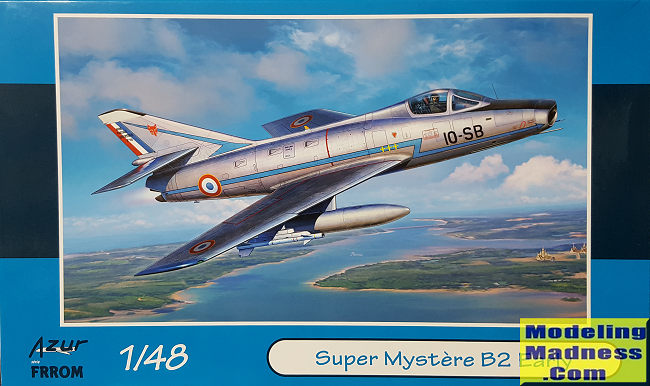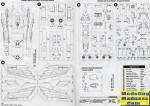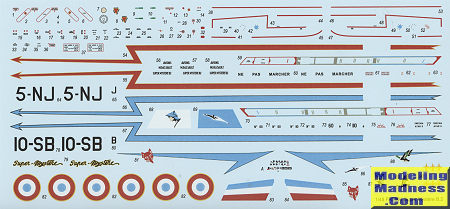
Azur FRROM 1/48 Super Mystere B.2 'Early'
| KIT #: | FR 7001 |
| PRICE: | $45.00 delivered |
| DECALS: | Two options |
| REVIEWER: | Scott Van Aken |
| NOTES: | 2023 release |

| HISTORY |
The Super Mystère represents the final step in evolution which began with the Dassault Ouragan and progressed through the Mystère II/III and Mystère IV. While earlier Mystère variants could attain supersonic speeds only in a dive, the Super Mystère could exceed the speed of sound in level flight. This was achieved thanks to the new thin wing with 45° of sweep (compared with 41° of sweep in the Mystère IV and only 33° in Mystère II) and the use of an afterburner-equipped turbojet engine.
The first prototype Super Mystère B.1, powered by a Rolls-Royce Avon RA.7R, took to the air on 2 March 1955. The aircraft broke the sound barrier in level flight the following day.
As the Super Mystère B.2, sometimes known as the SMB.2, the aircraft entered production in 1957. The production version differed from the prototype by having a more powerful SNECMA Atar 101G engine. A total of 180 Super Mystère B.2s were built.
In 1958, two Super Mystère B.4 prototypes were built. Equipped with a new 48° swept wing and a more powerful SNECMA Atar 9B engine, the aircraft were capable of Mach 1.4. Production never materialized because the faster Dassault Mirage III was entering service.
In 1973, the Israeli Air Force and Honduras Air Force upgraded their Super Mystère B.2s with a non-afterburning version of the Pratt & Whitney J52-P8A and new avionics. In Israeli service these upgraded SMB.2s were also known as the IAI Sa'ar (after a Hebrew word meaning "storm").
The Super Mystère served with the French Air Force until 1977. In addition, 24 aircraft were sold to the Israeli Air Force in 1958. The aircraft saw action in the 1967 Six-Day War and the 1973 Yom Kippur War. They were well liked by the Israeli pilots and were a match for the Arab MiG-19 aircraft in air-to-air combat.
In 1976, Israel sold 12 complete airframes to Honduras. In 1979, Honduras purchased 4 more complete airframes, totaling 16 aircraft. They were involved in numerous border skirmishes with Sandinista Nicaragua and were finally withdrawn from service in 1996, replaced by 12 Northrop F-5Es. The 11 surviving aircraft are for sale as surplus and 1 more is preserved at the Honduras Air Museum.
| THE KIT |
 For
decades, the only nice Super Mystere available in this scale has been by F.M. a
kit that is both very much a short run offering and also difficult to find. Thanks to the Special Hobby/Azur/FRROM folks, we now have an up
to date kit. You would expect one with a lot of parts and we do have that. In
addition, there are no photo etch and no resin parts, which pleases those who
do not like dealing with these materials.
For
decades, the only nice Super Mystere available in this scale has been by F.M. a
kit that is both very much a short run offering and also difficult to find. Thanks to the Special Hobby/Azur/FRROM folks, we now have an up
to date kit. You would expect one with a lot of parts and we do have that. In
addition, there are no photo etch and no resin parts, which pleases those who
do not like dealing with these materials.
Some of the features of the kit are full intake and exhaust that start and end with the compressor stages, a well done cockpit with a decal for the instrument panel, and a separate external exhaust piece for those boxings to come that have the extended tailpipe section. There is no indication of any nose weight, but there is room above the intake for it. The underside of the intake is the nose gear well. A separate nose piece is also provided. Note that there are several inserts for various fuselage vents and intakes. This is undoubtedly to allow for minor differences compared to the later boxings.
Wings are an upper and lower wing section and the upper section has the outer well piece. The inner piece is inserted into the appropriate fuselage half prior to assembling the halves. Landing gear are very nicely molded with all the oleo scissors molded in place. Gear doors are also nicely done and there are no ejector marks on the inside. The inner main gear doors are usually closed on the ground, but open options are provided.
 The kit instructions have you
complete the seat late in the process and there are
five pieces to this assembly. You are able to pose the canopy open or closed and
separate pieces are included. Unlike the 1/72 kit, there are no underwing fuel
tanks nor are there missiles/pylons. Not sure why these are not included,
especially the fuel tanks as these were used a lot and are even shown on the box
art.
The kit instructions have you
complete the seat late in the process and there are
five pieces to this assembly. You are able to pose the canopy open or closed and
separate pieces are included. Unlike the 1/72 kit, there are no underwing fuel
tanks nor are there missiles/pylons. Not sure why these are not included,
especially the fuel tanks as these were used a lot and are even shown on the box
art.
Instructions are superb and in color. Paint references are with Gunze paints. Both options are in unpainted metal with a black anti-glare panel on the nose. The box art plane is from EC 1/10 'Valois' from 1961. It has blue trim. The other is from EC 1/5 'Vendee', a red trimmed aircraft also from 1961. The modeler will need to paint the blue and red wing tips. The sheet is superbly printed by Cartograf.
| CONCLUSIONS |
I built the 1/72 kit and thoroughly enjoyed the experience. It is nice to see this one offered in the larger scale and it should also prove to be a great build.
| REFERENCES |
https://en.wikipedia.org/wiki/Dassault_Super_Myst%C3%A8re
November 2023
Copyright ModelingMadness.com. All rights reserved. No reproduction in part or
in whole without express permission from the editor.
If you would like your product reviewed fairly and fairly quickly, please
contact
the editor or see other details in the
Note to
Contributors.
Back to the Main Page
Back to the Review
Index Page
Back to the Previews Index Page